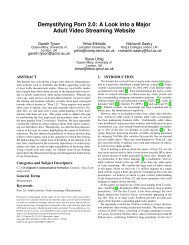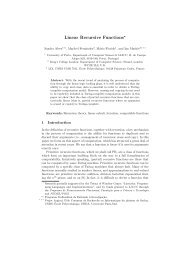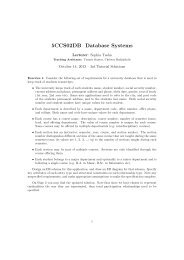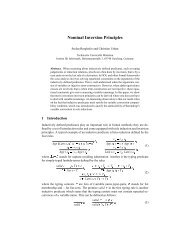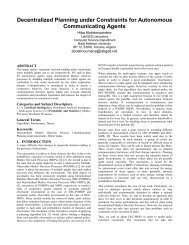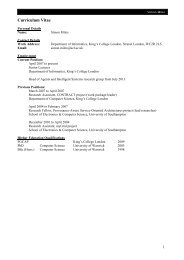Upgrade Report - Department of Informatics - King's College London
Upgrade Report - Department of Informatics - King's College London
Upgrade Report - Department of Informatics - King's College London
- No tags were found...
Create successful ePaper yourself
Turn your PDF publications into a flip-book with our unique Google optimized e-Paper software.
4Part IIRelated Work4 Network properties and metricsOur particular area <strong>of</strong> research is relatively new. This is mainly due to the fact that it is only recentlythat these network structures have emerged. It started with the emergence <strong>of</strong> the WWW, however work ongraph generation models greatly predates the rise <strong>of</strong> the WWW and was previously done to model socialnetworks in the domain <strong>of</strong> social sciences.The WWW graph in particular has received a great deal <strong>of</strong> attention. This graph is the result <strong>of</strong> modelingthe WWW as a set <strong>of</strong> pages which are the vertices <strong>of</strong> the graph, and a set <strong>of</strong> directed links between the pageswhich are the edges <strong>of</strong> the graph [32]. There are some very interesting properties that have been discoveredin this graph, for example the degree distribution observed follows a long-tail distribution [11, 49]. This isapparently a common attribute that is present in the WWW graph, as well as the Internet (autonomoussystems) [24], citation graphs [51], OSNs [24] and many others.4.1 Diameter and degree distributionThe diameter <strong>of</strong> the aforementioned networks seems to be relatively small and a “small world” phenomenonhas been observed. This means that the diameter d, or effective diameter [52] is <strong>of</strong> the scale <strong>of</strong> d ∝ log Nwhere N is the size <strong>of</strong> the graph. However according to a study by J. Leskovec et al [31] it was proposed thatthe diameter is even smaller than this proposed value. It is unclear whether or not this observed characteristic<strong>of</strong> certain networks is related to another observed characteristic <strong>of</strong> an edge densification power-law [31] where|E(t)| ∝ |V (t)| α where E(t) and V (t) are the sets <strong>of</strong> edges and vertices at the epoch t respectively and α isnot trivial (α > 1).The graphs with the above properties are commonly referred to as power-law graphs or scale-free graphs,however the latter term is controversial. For simplicity’s sake we will use the term power-law graphs andscale-free graphs interchangeably to refer to all graphs which have power-law degree distributions, a diameterless than or equal to the expected diameter <strong>of</strong> a small-world network. Additionally we will require our scalefreegraphs to have a scale invariance where these basic properties remain true even at very different sizes<strong>of</strong> the graph. According to the work <strong>of</strong> Dill et al [19] the web graph presents with a self-similar structurewhich may be the cause <strong>of</strong> the aforementioned scale invariance <strong>of</strong> the web-graph, it may be reasonable toassume that many other scale-free graphs observed such as OSN graphs share this characteristic with theweb-graph. We believe that this is an interesting research objective for our current work.4.2 Degree correlationsThe term “degree correlations” is used to denote the relationship between the degree <strong>of</strong> a vertex and thedegree <strong>of</strong> its neighbors. In the work <strong>of</strong> Pastor-Satorras et al [48] it has been suggested that there are greaterthan expected degree correlations in real world networks. The metric defined was based on the conditionalprobability P c (k ′ /k) which denotes the probability <strong>of</strong> a node <strong>of</strong> degree k is connected to a node <strong>of</strong> degree k ′ .As it is stated by Pastor, due to the statistical fluctuations, measuring this probability is a rather complextask. He suggested the following alternative:〈k nn 〉 = ∑ k ′ P c (k ′ /k) (4.1)This denotes an average value <strong>of</strong> this metric.4.3 Expander graphsIn general when we talk about the expansion property <strong>of</strong> a graph, or if we describe a graph as an expanderwe may mean several different properties may hold for a graph. Expander graphs were first defined by



